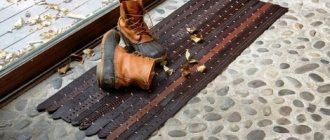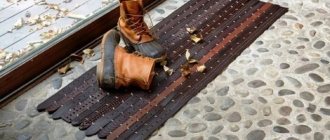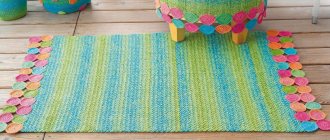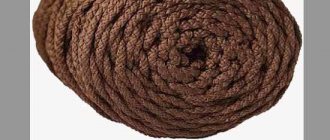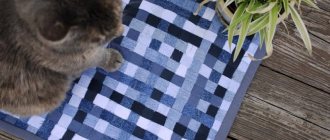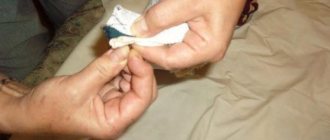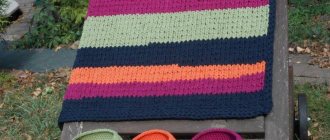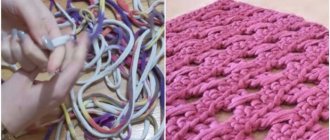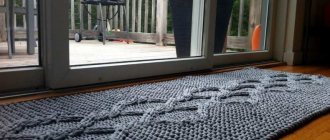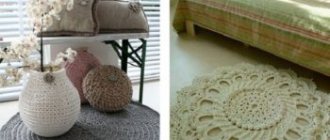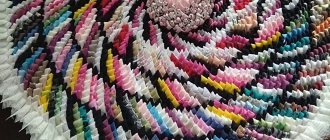It would seem, how can an ordinary small rug change the interior? But it turns out that it can become not only useful, but also a bright, interesting detail in interior design. Of course, you can buy it in a store, fortunately, now there are rugs for every taste and color. But think how nice it will be when you make it yourself, especially since such a rug can be easily made from old things, for example: threads, fabrics, wine corks, belts, and much more. All you need is to know the step-by-step instructions, stock up on the necessary materials and patience.
Rug made from old leather belts
Making a mat from belts is very simple.
For this you will need:
- 10-12 natural or faux leather belts
- awl or leather punch
- twine or string.
First make the belts the same length by cutting off the buckle. Make holes along the edges of the straps at a distance of approximately 2-3 cm from each other and 0.5 cm from the edge. Sew them together using thin hemp rope. The order of pulling the rope is arbitrary; you can sew along the belts, across, crosswise between the holes. Metal staples instead of rope will also look very stylish.
Fabric-based products
You can use fabric as a backing: burlap. Prepare 2 by 10 scraps and get to work. Thread each piece into the cell evenly across the entire width of the base, the tighter the better. This way the rug will be fluffy and soft.
Before creating a rug from old T-shirts turned into yarn, trim the ends of the fabric and select the shape.
This rug is perfect for both the hallway and the bathroom.
Soft rug made from old fabrics
Required material:
- scissors
- pieces of old (unnecessary) fabrics, maybe old clothes
- bath mat (with holes)
1. Cut the fabric into small strips
2. Using tweezers or a hook, begin pushing the strips through the holes.
3. Tie all fabric strips with a simple knot.
Making a rug from old towels
Required material:
- old towels
- scissors
- sewing machine (needle and thread)
1. Cut your towels into several strips. In this example, each strip is about 3 - 4 cm wide.
For convenience, you can fold each towel in half and cut it into 2 halves. Fold each half in half again and cut along the fold line, etc. It is advisable that all towels are approximately the same size.
2. Place 3 strips of different colors together and secure them with thread (stitch the ends). Start braiding these strips. After finishing the weaving, stitch the ends again.
3. Make several of these “braids” and then connect them into one long strip using a needle and thread (or a sewing machine).
4. Start rolling your long strip into a spiral, securing it with a thick thread.
5. Secure the entire structure and turn it over so that the seams are on the bottom.
Your rug is ready!
Custom ideas for a rug
Environmental enthusiasts are making adorable moss exhibits that will bring back the feeling of being in nature to city dwellers. A model made from bags of different diameters and colors with soft or loose filling looks very nice.
Charming rugs come from bath towels that captivate with their softness; they are appropriate in a bedroom or children's room. Some go further and sew voluminous fragments that fit together like puzzles.
Simple ways to make a rug for beginners include rope variations.
- This material is fertile ground for beginners. Thick ropes are used from a diverse arsenal, twisting them in a spiral and gluing them to a backing.
- You can do the same with twine, or you can weave it into braids and gather it in a circle, or reproduce any geometric figures, the connection of which produces a patterned design.
Pieces of cotton rope are tied around the mesh cells, secured with threads, now the ends must be separated so that the object acquires frivolous fluffiness. What about pom poms? They are made from the remnants of multi-colored yarn, wound around the palm, tied in the middle and cut off the outer loops.
Delightful pompoms are tied to a mesh, creating incredible beauty that looks like clouds. You can use the shape of a heart or a star at the discretion of the master.
Wine cork rug
Wine bottle corks are an excellent material for a variety of crafts for the home and garden. One useful option is to make your own cork mat. Cork bark practically does not absorb moisture and bacteria do not multiply in it, which is why cork is excellent for rooms with high humidity, that is, for the bathroom. And walking on a mat of traffic jams is not only very pleasant, but also useful!
To make a small rug, you will need:
- 150-180 wine corks;
- glue;
- a piece of water-repellent material for the base (rubber shower or yoga mat, rubberized fabric, soft thin plastic);
- sharp knife;
- coarse sandpaper;
- cutting board.
1. Assemble and prepare the plugs. If you do not have the required quantity, you can buy plugs in online stores. Wash them thoroughly in warm soapy water. To remove red wine stains, soak the corks in a bleach solution and leave them overnight. Then rinse well and leave to dry.
2. Cut each cork lengthwise into two pieces. Use a cutting board and a sharp knife. If the cuts are very uneven, smooth the edges with sandpaper. For convenience and safety, it is better to cut the cork not on its side, but by placing it in a vertical position.
3. Place the corks with the cuts down on the table as they will be located on the rug, decide on the size of the future rug. Then cut the base of the rubber material to the desired size. You can come up with a pattern yourself, it can be a checkerboard pattern, even rows, zigzags.
4. Start gluing the corks to the base with an adhesive suitable for gluing such surfaces. Glue the corks around the perimeter first, then moving towards the center. Remove excess glue immediately with a cloth.
The cork mat must dry completely. To make it completely waterproof, you can treat the surface with a sealant. If you use a cork mat in the bathroom, it is advisable to dry it in the sun at least once a month for prevention.
Interesting handicrafts for home and garden photo
Every housewife dreams that her home will be not only comfortable, but also attractive. An excellent solution would be handmade items that fill the home with special energy and warmth. Having mastered the craft of patchwork, you can decorate your bedroom with an unusual blanket or rug. For those who know how to knit, there are a huge number of ideas for various rugs, furniture covers, decorative pillows and other interior items. With a well-chosen color scheme, such items will add special charm and originality to the interior.
Rug woven from shreds
Materials needed for making it yourself:
- thick fabric (carpet base)
- pieces of fabric
- black thread
- needle
- scissors
- fabric glue
- adhesive tape
- spray for protective coating (if desired)
1. Select the size of the carpet and prepare a cloth of the appropriate size.
2. Prepare long strips of fabric. Each strip should be approximately 6-7 cm longer than the main part of the carpet.
3. Prepare several bundles of 3 strips and start braiding. You need several blanks so that you can combine them into one carpet. For convenience, secure the ends of each piece with adhesive tape. Don't weave all the way through - leave some of the fabric unwoven.
4. Apply glue to a thick canvas. No need to skimp on glue.
5. Carefully place the blanks on the canvas so that they stick.
6. Connect all the pieces together using a needle and thread.
7. Remove the duct tape from the ends. Trim the ends so they are even.
The rug is ready!
Handicraft ideas for the home, interesting crafts and patterns
You can approach any piece of furniture in the room creatively, and give even an ordinary stool brightness and individuality. To do this, just attach a lot of multi-colored cords folded in half to the case. For reliability, they must be properly stitched from the inside. Such an item will become a source of pride and admiration.
An interesting idea for skilled needlewomen is to create a children's mobile with your own hands. Colorful pom-poms will attract children's attention in every possible way and will decorate their room. To do this, just attach the parts to a strong thread and connect them together, attaching them to the crib.
Funny pillows in the shape of butterflies will certainly enliven the interior of both the children's room and the hallway. To do this, just make a cardboard pattern of the required dimensions, transfer it to fabric and cut it out. Then carefully connect the parts using a sewing machine, leaving a hole for filling. Fill the pillow with synthetic padding and sew up the hole with a hidden seam.
DIY pompom rug: Option No. 1
Required material:
- wool thread
- scissors
- bath mat (with holes)
1. Wrap the wool thread around your fingers (the more you wrap, the fluffier the pompom will be).
2. Carefully remove the wound thread from your fingers. Prepare another short thread - about 20 cm long - and tie it around the wound thread (in the middle).
3. Cut off the ends with sharp scissors. Also cut off the excess parts with scissors to get a neat round pompom. But don't cut the thread you used to tie the pompom, you'll need it later.
4. Make enough pom poms to cover the bath mat. After this, begin to thread the thread through the holes and tie it to the rug, thereby attaching the pom poms to the rug. The pompoms should be close to each other.
5. When you have tied all the pompoms to the carpet, you can cut off the ends of the threads.
Your DIY pompom rug is ready!
Where to use the products
There are many ways to use a hand-sewn fabric rug. It can be placed in the center of the room, making it more comfortable. Some people will prefer a rug lying next to the bed - after all, it will be very pleasant to get out of bed in the morning on a soft and cozy product. Can be placed in the bathroom and hallway. Or even hang it on the wall! And another win-win option for using the rug is to give it as a gift to a loved one. After all, as they say, the best gift is the one made with your own hands. And to understand how they look in practice, you can see photos of fabric rugs made by yourself in the article. It's really unusual and beautiful.
Simple pompom rug: Option No. 2
To make this blue and white pompom rug, you will need:
- thick woolen threads for knitting;
- mesh base for the rug;
- scissors.
1. Make pom-poms in different colors to create a smooth gradient color transition. You can make a plain rug or lay out a specific pattern. You can also play with the size of the pompoms, using large, smaller and very small ones. To do this, look here for the best way to make pompoms of different sizes.
2. Now tie each pompom to the net, following the color scheme. Try not to see the outline between the pom-poms.
If desired, the back side of the rug with knots can be covered with fabric or knitting so that the pompom rug is beautiful from all sides, even from the inside out. If you couldn’t find a suitable base - a mesh - it doesn’t matter, pompoms can simply be sewn to any fabric.
"Stone" carpets
Despite their “hard” name, these rugs will give you a cozy and homely atmosphere.
They are made from:
- Fabric base;
- scraps of fabric,
- Sintepon or cotton wool.
Pieces of filler are placed in small patches (they can be of various sizes. In this case, the carpet will give the impression of the seabed or an uneven garden path).
The patches are sewn together in the manner of knots and sewn to the base. From multi-colored “pebbles” you can create an unusual pattern or put together a whole picture.
Round foot mat made with a hoop
Old knitted T-shirts are actively used by craftswomen for a variety of crafts; in particular, the idea of making rugs out of them is very popular.
Necessary materials:
- 3-4 T-shirts (other things, ribbons or ropes)
- children's gymnastic hoop or hula hoop for adults scissors
It is recommended to take items made of fabric with a minimal admixture of elastane, tape or just rope.
The size of the mat depends on the size of the chosen hoop; you can take either your daughter’s gymnastics hoop or a large weight loss hoop. The weaving technology is very simple; even a child can do it by making a round rug on a hoop for their room.
Cut T-shirts or other old outerwear into strips of equal width, from one side seam to the other, to form rings. Place each strip on the hoop: first a vertical line, then a horizontal one, and then divide each sector into equal parts with a strip of a T-shirt.
Important! The strips of fabric should not be very stretched, otherwise the finished rug will wrinkle and will not hold its shape. Ideally, the T-shirt strip should fit almost loosely over the hoop, with minimal stretching of the fabric.
It's likely that if the diameter of your hoop is larger than the t-shirt strip, it's too tight or you're using ropes at all. In this case, simply wrap the hoop in fabric or rope and tie a knot.
Try to have all the base lines intersect at the center point. We start weaving the rug from the center. Take a strip of T-shirt, fasten it with a loop to one of the warp lines and pass it under and over the longitudinal lines.
When the strip ends, tie another T-shirt ring to it, hiding the knot under the previous row. Continue weaving in the same way, alternating between pulling the strip under and over the longitudinal lines. Try to keep each circle pressed tightly against the previous one, avoiding large spaces or holes between them. Once you have finished weaving, cut off the ends of the loops with scissors and tie them with a knot.
Weaving on a hoop
The plastic gymnastic hula hoop provides ease of use. Instructions on how to properly make a rug with your own hands:
- We stretch two strips crosswise onto the frame.
- We continue manipulating other segments, creating a structure similar to a bicycle wheel with an odd number of axles.
- Weaving is done from the center, running ribbons under stretched rulers.
- Having reached the middle, we begin to separate the fundamental loops in two for a dense structure.
- Finally, we tie the thread edges with strong knots.
- Having cut the object from the circle, we strengthen the ends.
Another interesting option on the frame. Nails are driven into the wooden frame at intervals of 2 cm on both sides. Fabric ribbons are attached to them, through which contrasting elements will pass above and below the main samples. The final edge is tied with a knot and the product is removed from the device.
Illuminated rug
Sometimes at night you want to go to the toilet, go to the kitchen to eat, drink a glass of water or prepare a bottle of formula for the baby, so you have to get up and leave the bedroom. In the dark, and even in a half-asleep state, there is a risk of bumping into something, and turning on the overhead light is not always possible so as not to wake up other family members. For such cases, LED floor lighting in a rug will be an interesting and useful solution.
Craftswoman Johanna Hyrkas came up with the great idea of using an LED strip as a lighting sign for the way out of the bedroom. The ribbon is twisted in a spiral, located inside a round rug woven from ordinary rope, and a long tail leads further from the room. Soft, cozy light spreads across the floor without disturbing sleep.
Such a rug with LED lighting can serve as a night light in a child’s room. In addition, a strip of rug can be laid along the walls and lead to the toilet or kitchen. For such purposes, it is better to use a sealed closed LED strip. You can make a rug with your own hands, using a large crochet hook or using your fingers to braid a ribbon with thick yarn or rope. Of course, there are expensive models of LED floor lighting with a light power control. But often the homemade option is an excellent budget solution, as in this case.
The most unusual homemade rugs
In addition to the usual household items, the following items are used to make homemade rugs:
- Gymnastic hoop and old items of clothing.
- The original combination of a soft wicker rug with an LED strip is an example of a practical night rug.
- Lids made from plastic bottle caps.
Some craftsmen can make a rug from willow wicker or rattan.
Rug made from jeans labels
The concept of using clothing items for other purposes after they have been worn out is not new. For decades, women have been making patchwork rugs and quilts from old items. In the same way, you can make a carpet with your own hands from labels from jeans. The only problem is finding enough labels, because even for a small rug you will need at least 50 pieces.
To make such carpets with your own hands, it is better to sew labels onto some kind of fabric, maybe even thin. Labels sewn on each other will give the carpet the necessary density. For work, use a sewing machine, since manually sewing each label is a very labor-intensive task. Make stitches around the perimeter of the label, where it was sewn to the jeans. You can choose the pattern yourself - the correct even mesh, herringbone, spiral for a round carpet, but labels in a slightly irregular order, sewn on top of each other, look most impressive.
Mesh based products
Buy a regular repair mesh and prepare material from scraps of fabric. The optimal size of the shreds is 2 by 10. Making a carpet.
The mesh is a good helper in creating a rug from old and outdated T-shirts.
- We cut out the desired shape of the future work from the grid.
- The center of the product is the beginning of work. We pass the scrap from the bottom of the mesh to the top so that you can tie a knot.
- We perform this manipulation in each cell.
They step back 1 cm from the edge and begin to fasten scraps of fabric measuring 2*12 cm into the cells.
It’s easy and simple to make such a rug without a hook or special tools from old T-shirts with your own hands.
The shreds are brought in from the bottom of the mesh, pulling them up using a hook.
As a result, you will have a cozy shaggy rug.
How to make a rug "French bracelet"
Required material:
- old fabric of 2 colors (you can use old T-shirts). The width of each piece of fabric is 20-25 cm and the length is 3 meters. If you are using old T-shirts, you can join several pieces together with a thread and a needle.
- scissors
- needle and thread
- adhesive tape
1. Arrange 5 strips of different colors in the order in which you want them to look on the future carpet.
2. Next to the 5 laid out strips, place another 5 strips in a mirror image.
3. Take the first strip, in this case the pink one, and tie it as shown in the image. First, fold the fabric to form a number 4.
4. Continue tying the pink strip around the remaining strips until you reach the middle.
5. Start doing the same on the opposite side, tying another pink stripe around the other 4 stripes. Start also with the number 4, but in a mirror image.
6. When the two pink stripes meet in the middle, tie them together.
7. Repeat the same with the subsequent remaining strips. Choose the length of the rug yourself.
8. Start another rug, choosing the same colors. After this, connect both rugs with thread and needle.
Tip: If you wish, you can make one or more similar rugs, which can then be sewn into one large rug.
9. Excess parts can be cut off and the ends secured with thread to prevent them from unraveling.
Crochet blanket in patchwork style master class
A more complex option for creating a rug, requiring patience and perseverance, is crocheting in patchwork style. The main feature of this technique is to create small parts of a certain shape for further connection into a whole canvas. The number of such components determines the size of the future product.
To create a rug, you need to prepare several shades of yarn, an appropriate size hook, and scissors.
Operating procedure:
To create a piece for a rug, you need to create the required number of squares, which should subsequently be sewn. To create a part measuring 16 by 16 cm, you must follow the order:
- We collect a chain of 19 air loops.
- At the beginning of the second row we make 3 chain stitches and 18 double crochets.
We knit the next 11 rows according to the pattern:
The required number of finished parts should be sewn together. For a small rectangular product, 8-10 squares are enough; for a larger rug, at least 20 squares should be knitted. We sew the parts according to the following picture:
To ensure the integrity of the product, the edge of the rug must be tied with 2 rows of single crochets. Such a rug will be an excellent solution for both an apartment and a cottage, adding a colorful touch to the interior.
